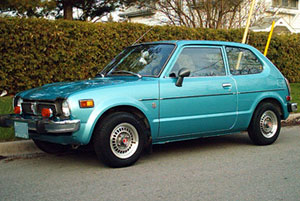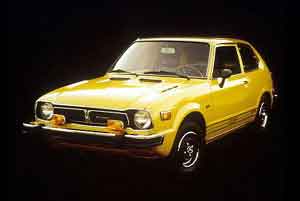
What is Honda Civic Style CVCC (1500)
1StGenCiViC The longest of the hatchbacks, First Generation Honda Civic's
- Randy
- Administrator

- Posts: 1447
- Joined: April 7th, 2005, 9:06 pm

- Province/State: Ontario
- Hometown: Ajax
- Model: 1978 Hatchback
 What is Honda Civic Style CVCC (1500)
What is Honda Civic Style CVCC (1500)
What is CVCC
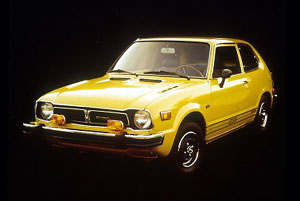 The CVCC engine debuted in 1975. Offered alongside the standard Civic engine, the 53-horsepower CVCC engine displaced 1,488 cc and had a head design that promoted cleaner, more efficient combustion. The CVCC design eliminated a need for a catalytic converter or unleaded fuel to meet emissions standards. (Nearly every other U.S. market car for this year underwent the change to exhaust catalysts and the requirement to use only unleaded fuel.) Due to California's stricter emissions standards, only the Civic CVCC was available in that state. A five-speed manual gearbox became available this year, as did a Civic station wagon (only with the CVCC engine).
The CVCC engine debuted in 1975. Offered alongside the standard Civic engine, the 53-horsepower CVCC engine displaced 1,488 cc and had a head design that promoted cleaner, more efficient combustion. The CVCC design eliminated a need for a catalytic converter or unleaded fuel to meet emissions standards. (Nearly every other U.S. market car for this year underwent the change to exhaust catalysts and the requirement to use only unleaded fuel.) Due to California's stricter emissions standards, only the Civic CVCC was available in that state. A five-speed manual gearbox became available this year, as did a Civic station wagon (only with the CVCC engine).
A CVCC engine has a special cylinder head. The CVCC head uses a stratified charge combustion chamber. A stratified combustion mixture is richer at the sparkplug and much leaner at the main part of the combustion chamber. The rich mixture is easily ignited by the sparkplug and this initial flame will ignite the remaining leaner mixture. The CVCC head uses a pre-combustion chamber that is about the size of a thimble. The CVCC carburetor is actually two carburetors in one, a lean part and a rich part. The lean part feeds the main combustion chamber and the rich part feeds the pre-combustion chamber. The rich mixture in the pre-combustion chamber is ignited . A "flame hole" in the pre-combustion chamber allows the pre-combustion flame to blow across the regular combustion chamber and ignite the lean mixture.
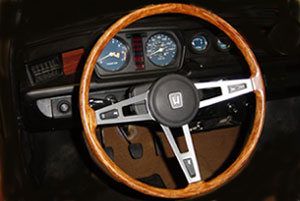 How to identify a CVCC:
How to identify a CVCC:
-1500cc engine, designated ED1
-They say CVCC on the rocker cover
-The hose for the air filter goes to driver's side fender
-2.17" length increase in the front fenders to accommodate the larger CVCC engine
-Water pump is on the back drivers side and alternator is on the front
-3 spoke steering wheel (either wood grain or black)
-5 speed CVCC's have a deluxe gauge cluster- tachometer/Speedo and Fuel/Temp gauges on the center of the dash
-Hood has a split scoop type vent in front of the wind shield on later models.
-Rear struts on the hatch & coupe models are straight and similar in design to the front. Un-like
the 1200 models have a U-shape bracket welded to the bottom.
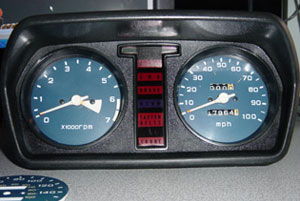
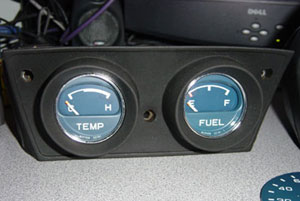
**Notes:
75 CVCC Sedan= 8.1:1, Wagon= 7.7:1
Additional Information
73-79 Chassis code was designated SB
-75 CVCC: introduced as a way around stricter emissions
-76-79 CVCC: engine was revised internally, producing slightly more power and smoother running
-The 75-79 CVCC was the only first generation engine equipped with a 5spd transmission
-The CVCC's are longer in the nose to accommodate the slightly larger motor (2.17" to be exact)
-73-79 Civics did not have trim level specifications but were differentiated by their motor types
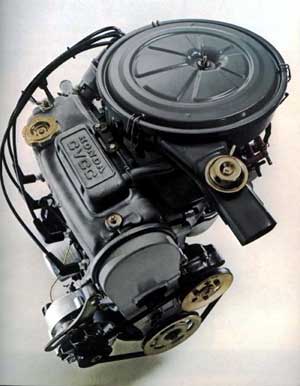
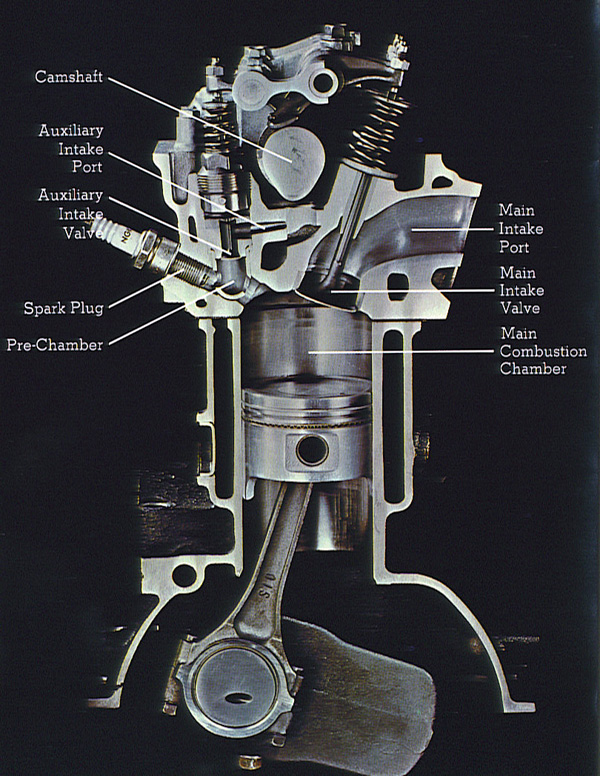
There are two basic ways for simultaneously lessening the amount of carbon monoxide, unburned hydrocarbons, and oxides of nitrogen in the exhaust of internal combustion engines: (1) Cleaning up the exhaust by means of a catalyst or other add-on devices, or (2) Employing a very lean overall mixture (excess oxygen) and regulating its combustion to suppress production of the unwanted pollutants. Conventional and rotary engines ues the first method. The Honda CVCC engine uses the second.
The Conventional Engine
The conventional engine operates best with an air-fuel mixture that is on the rich side. If the mixture is made too lean, the engine will begin to misfire because a lean mixture is difficult to ignite with a spark plug.
To meet the 1975 California standards, the conventional rich mixture system generally requires the addition of an air pump and either a catalytic converter or a thermal reactor to reduce the emission of unburned hydrocarbons and carbon monoxide. In addition, some engines require exhaust gas re-circulation to limit production of oxides of nitrogen.
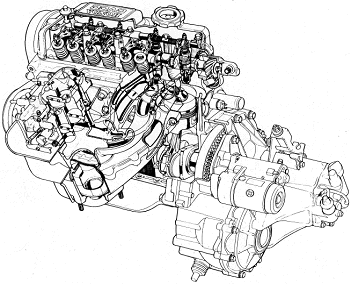
The CVCC Engine
The CVCC engine is designed so that a very lean overall mixture can be burned. The regulated burning of this lean mixture with its excess of oxygen enables the CVCC system to meet the 1975 California standards without the addition of the air pump, catalyst, or exhaust gas re-circulation required by most other engines.
Structure of The CVCC Engine
Each cylinder in the CVCC engine has two chambers; a main combustion chamber, and a pre-chamber.
Each of these chambers has its own inlet valve. A spark plug ignites the mixture in the pre-chamber. Connecting the pre-chamber with the main combustion chamber is an opening designed to direct the flame from the pre-chamber into the main combustion chamber.
How The CVCC Engine Operates
Suction Stroke

On the intake stroke, a large amount of very lean mixture is drawn through the main intake valve into the main combustion chamber. At the same time, a very small amount of rich mixture is drawn through the auxiliary intake valve into the pre-chamber.
Compression Stroke

At the end of the compression stroke, a rich mixture is present in the pre-chamber, a moderate mixture is formed in the main combustion chamber near the pre-chamber outlet, and a very lean mixture is present in the remainder of the main combustion chamber.
Ignition

When the spark plug fires, the rich mixture in the pre-chamber is easily ignited.
Expansion Stroke

The flame from the pre-chamber ignites the moderate mixture and this, in turn, ignites the lean mixture in the main combustion chamber. The formation of carbon monoxide is minimized because of this lean mixture.
Bottom Dead Center

The stable and slow burning in the main combustion chamber has two desired effects. The peak temperature stays low enough to minimize the formation of oxides of nitrogen. And the mean temperature is maintained high enough and long enough to substantially reduce hydrocarbon emissions.
Exhaust Stroke

The hot gases exit through the exhaust valve, and oxidation continues in the manifold.
 The CVCC engine debuted in 1975. Offered alongside the standard Civic engine, the 53-horsepower CVCC engine displaced 1,488 cc and had a head design that promoted cleaner, more efficient combustion. The CVCC design eliminated a need for a catalytic converter or unleaded fuel to meet emissions standards. (Nearly every other U.S. market car for this year underwent the change to exhaust catalysts and the requirement to use only unleaded fuel.) Due to California's stricter emissions standards, only the Civic CVCC was available in that state. A five-speed manual gearbox became available this year, as did a Civic station wagon (only with the CVCC engine).
The CVCC engine debuted in 1975. Offered alongside the standard Civic engine, the 53-horsepower CVCC engine displaced 1,488 cc and had a head design that promoted cleaner, more efficient combustion. The CVCC design eliminated a need for a catalytic converter or unleaded fuel to meet emissions standards. (Nearly every other U.S. market car for this year underwent the change to exhaust catalysts and the requirement to use only unleaded fuel.) Due to California's stricter emissions standards, only the Civic CVCC was available in that state. A five-speed manual gearbox became available this year, as did a Civic station wagon (only with the CVCC engine).A CVCC engine has a special cylinder head. The CVCC head uses a stratified charge combustion chamber. A stratified combustion mixture is richer at the sparkplug and much leaner at the main part of the combustion chamber. The rich mixture is easily ignited by the sparkplug and this initial flame will ignite the remaining leaner mixture. The CVCC head uses a pre-combustion chamber that is about the size of a thimble. The CVCC carburetor is actually two carburetors in one, a lean part and a rich part. The lean part feeds the main combustion chamber and the rich part feeds the pre-combustion chamber. The rich mixture in the pre-combustion chamber is ignited . A "flame hole" in the pre-combustion chamber allows the pre-combustion flame to blow across the regular combustion chamber and ignite the lean mixture.
 How to identify a CVCC:
How to identify a CVCC:-1500cc engine, designated ED1
-They say CVCC on the rocker cover
-The hose for the air filter goes to driver's side fender
-2.17" length increase in the front fenders to accommodate the larger CVCC engine
-Water pump is on the back drivers side and alternator is on the front
-3 spoke steering wheel (either wood grain or black)
-5 speed CVCC's have a deluxe gauge cluster- tachometer/Speedo and Fuel/Temp gauges on the center of the dash
-Hood has a split scoop type vent in front of the wind shield on later models.
-Rear struts on the hatch & coupe models are straight and similar in design to the front. Un-like
the 1200 models have a U-shape bracket welded to the bottom.


Code: Select all
Year/Model Motor CC Bore Stroke HP TQ Compression
75-CVCC ED1 1488 74mm 86.5mm 53@5k 68@3k 8.1/7.7*
76-77-CVCC ED1 1488 74mm 86.5mm 60@5k 76@3k 7.9:1
78-79-CVCC ED1 1488 74mm 86.5mm 63@5k 77@3k 7.9:1
75 CVCC Sedan= 8.1:1, Wagon= 7.7:1
Additional Information
73-79 Chassis code was designated SB
-75 CVCC: introduced as a way around stricter emissions
-76-79 CVCC: engine was revised internally, producing slightly more power and smoother running
-The 75-79 CVCC was the only first generation engine equipped with a 5spd transmission
-The CVCC's are longer in the nose to accommodate the slightly larger motor (2.17" to be exact)
-73-79 Civics did not have trim level specifications but were differentiated by their motor types


There are two basic ways for simultaneously lessening the amount of carbon monoxide, unburned hydrocarbons, and oxides of nitrogen in the exhaust of internal combustion engines: (1) Cleaning up the exhaust by means of a catalyst or other add-on devices, or (2) Employing a very lean overall mixture (excess oxygen) and regulating its combustion to suppress production of the unwanted pollutants. Conventional and rotary engines ues the first method. The Honda CVCC engine uses the second.
The Conventional Engine
The conventional engine operates best with an air-fuel mixture that is on the rich side. If the mixture is made too lean, the engine will begin to misfire because a lean mixture is difficult to ignite with a spark plug.
To meet the 1975 California standards, the conventional rich mixture system generally requires the addition of an air pump and either a catalytic converter or a thermal reactor to reduce the emission of unburned hydrocarbons and carbon monoxide. In addition, some engines require exhaust gas re-circulation to limit production of oxides of nitrogen.

The CVCC Engine
The CVCC engine is designed so that a very lean overall mixture can be burned. The regulated burning of this lean mixture with its excess of oxygen enables the CVCC system to meet the 1975 California standards without the addition of the air pump, catalyst, or exhaust gas re-circulation required by most other engines.
Structure of The CVCC Engine
Each cylinder in the CVCC engine has two chambers; a main combustion chamber, and a pre-chamber.
Each of these chambers has its own inlet valve. A spark plug ignites the mixture in the pre-chamber. Connecting the pre-chamber with the main combustion chamber is an opening designed to direct the flame from the pre-chamber into the main combustion chamber.
How The CVCC Engine Operates
Suction Stroke

On the intake stroke, a large amount of very lean mixture is drawn through the main intake valve into the main combustion chamber. At the same time, a very small amount of rich mixture is drawn through the auxiliary intake valve into the pre-chamber.
Compression Stroke

At the end of the compression stroke, a rich mixture is present in the pre-chamber, a moderate mixture is formed in the main combustion chamber near the pre-chamber outlet, and a very lean mixture is present in the remainder of the main combustion chamber.
Ignition

When the spark plug fires, the rich mixture in the pre-chamber is easily ignited.
Expansion Stroke

The flame from the pre-chamber ignites the moderate mixture and this, in turn, ignites the lean mixture in the main combustion chamber. The formation of carbon monoxide is minimized because of this lean mixture.
Bottom Dead Center

The stable and slow burning in the main combustion chamber has two desired effects. The peak temperature stays low enough to minimize the formation of oxides of nitrogen. And the mean temperature is maintained high enough and long enough to substantially reduce hydrocarbon emissions.
Exhaust Stroke

The hot gases exit through the exhaust valve, and oxidation continues in the manifold.

 Gusto (August Boehm) of , was a member of this site owns and operates 1StGenCivic.Info,
Gusto (August Boehm) of , was a member of this site owns and operates 1StGenCivic.Info,I do not endorse the site nor was I asked for permission to use or re-publish the information from here.
He scraped the web for past pages that are already included in the database of this site known as 1StGenCivic.com/org or previous generations and upgrades.
I am closing site down as an open discussion forum.

